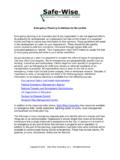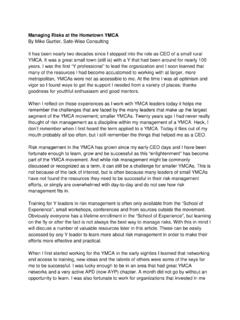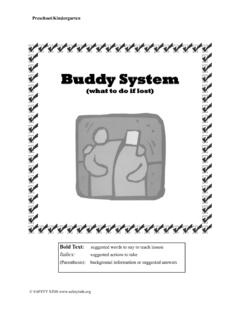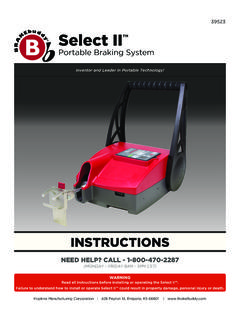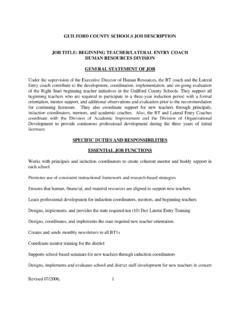Transcription of Buddy System Guideliens for Group Swimming - …
1 Copyright 2009 Safe-Wise Consulting, LLC All Rights Reserved Buddy System guidelines for Group Swimming Organization and swimmer management can be challenging during Group swim times; especially if the majority of the swimmers are youth. Heavy swimmer loads can create excessive surface agitation. This agitation coupled with glare can make bottom scanning very difficult and at times impossible. Dark water as found in lakes and ponds also adds to challenges for bottom scanning. Lifeguards need to be vigilant; actively scanning the pool, lake or pond while also enforcing the rules to ensure that nobody disappears below the surface and drowns. It is not enough to rely on vigilant Lifeguards that actively scan their zones of coverage.
2 Bather loads and conditions can inhibit effective scanning, particularly those as described above. Aquatic incidents can be silent, so organizations must look for additional strategies for swimmer management and accident prevention. The use of a Buddy System is a time-tested and effective swimmer management System that can help to prevent aquatic incidents. Buddy System The Buddy System entails pairing off all swimmers with another swimmer ( Buddy ) of similar Swimming ability. This is not only an effective way to help manage large groups, but it also reinforces the character development trait of responsibility. Each Buddy is responsible for the other. If their Buddy is having a problem, they can help to alert the aquatic staff.
3 Buddies must remain in the same area and should be instructed not to perform rescues in the case of emergency but to inform the Lifeguard that their Buddy is in trouble. If a Buddy needs to leave the water (ex. bathroom) for any reason their Buddy must also leave until both are ready to return. Swim Testing All youth should have their Swimming ability tested with the results being recorded for future use. Each swimmer must be limited to aquatic activity based on their swim ability. The use of bands or caps is encouraged to assist Lifeguards and other staff in indentifying swimmer ability. All swimmers under the age of 18 years should be deep water tested and banded.
4 Non-swimmers and shallow water competent swimmers must be restricted to water no deeper than their shoulders. A suggested ability test is available in the Safe-Wise Consulting Online Resource Library. Buddy Boards Swimmers leaving and returning to the swim area should be accounted for with a Buddy Board/Tag Board or Roll Call ( Buddy list) System . Buddy Board and Roll Call systems both work in a similar manner. Swimmers are accounted for before they enter the water and after their Swimming period is over. With the Buddy Board System , every swimmer gets a tag with his or her name on it. Swimmers hang their tag on a peg board as they enter the water and remove it when they leave the water; both under the watchful eye of a Lifeguard or aquatic staff member.
5 At the end of the swim period, the Group leader can easily check to see that all swimmers have left the water. Copyright 2009 Safe-Wise Consulting, LLC All Rights Reserved Buddy Checks Buddy Checks should be conducted at regular intervals during the swim period. The length of these intervals may be determined by local or state regulations. Conducting Buddy Checks at least every 10 minutes unless codes require greater frequency ensures that Buddies are near each other, being responsible, and that a check can be performed quickly and efficiently. The check is initiated by the Lifeguard using a predetermined signal (whistle blows). At the sound of the whistle blows all swimmers should clear the water and Buddy Up.
6 Swimmers should join and raise hands with their Buddy while standing at the water s edge or sitting on a pool s edge. A staff member should be assigned to scan the bottom and another to perform a Buddy Count. Staff must begin an immediate search if a Buddy is unaccounted for. When the water is clear and all Buddies are accounted for, the swimmers may re-enter the water and resume activities. Using this System does not exclude these swimmers from being tested prior to being allowed in the water. These are other points to consider for the prevention of aquatic accidents: A pool or waterfront should never be open without certified Lifeguard(s) on duty Lifeguards should rotate positions and be provided with regular breaks Lifeguards should have no other duties other than to scan and be vigilant Deep water is a relative description; 4 feet of water is deep to a child that is only 3 feet tall Swimming areas should be separated into a deep and shallow area by the use of a secure buoy line.
7 Dark water or lake and pond facilities are normally divided by secure buoy lines into the following areas; Red area (non-swimmers) Yellow area (shallow water competent) Green area (deep water swimmers) Diving boards, slides and other aquatic equipment should be separated from the Swimming area by a secure buoy line Additional Lifeguard(s) should be assigned to manage the diving and slide areas. All groups, camps, childcare, birthday parties and rentals should utilize the Buddy System for recreational Swimming More aquatic safety resources can be found at the Safe-Wise Consulting Online Resource Library





